Best Mayan Ruins in the Yucatan Peninsula
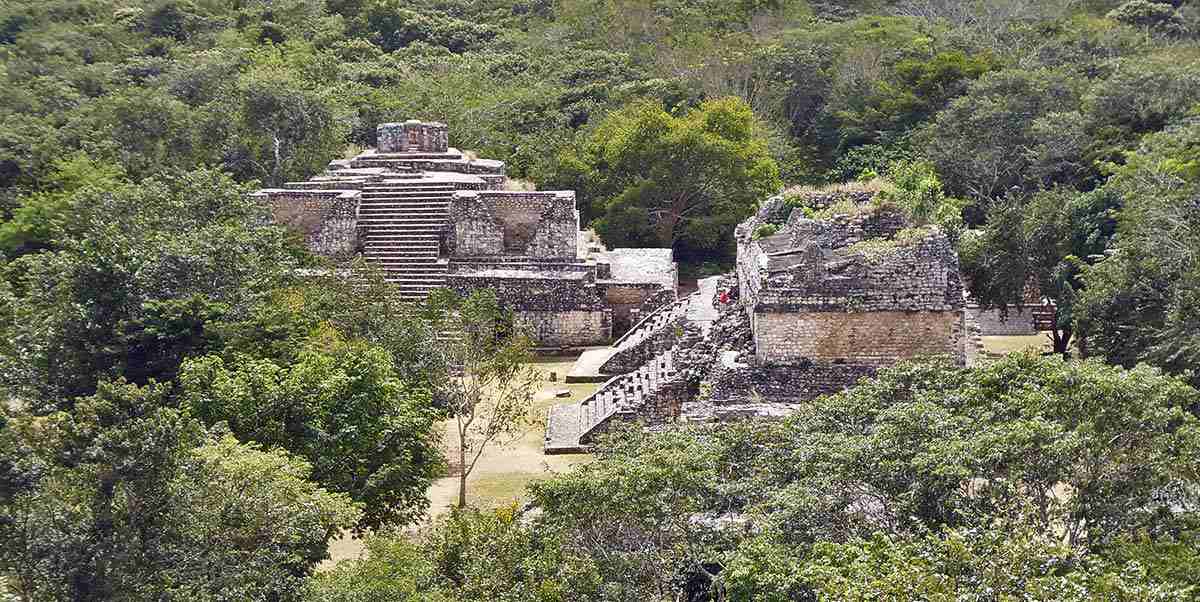
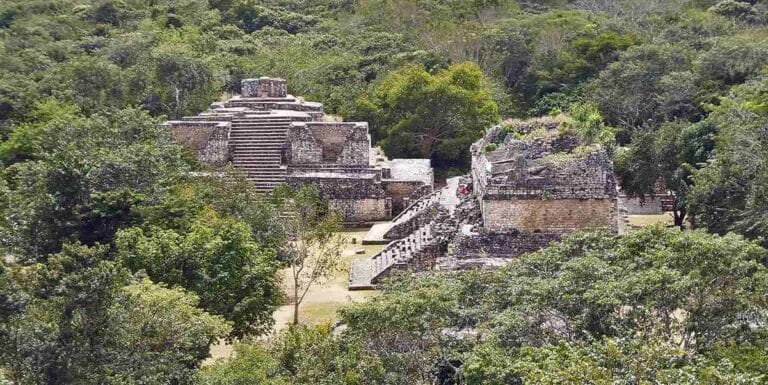
The Yucatan has much more to offer than its gorgeous Caribbean beaches. Even if you’re not a history buff, the amazing Mayan Ruins in the Yucatan Peninsula are a ‘must see’ for anyone visiting this region.
Many of these amazing archeological sites are within easy reach from your holiday destination, whether that’s Cancun, Playa del Carmen, Tulum, or Merida. And don’t worry about them being dry, dusty piles of rock. They’re not.
One of the most famous Mayan ruins in the Yucatan Peninsula is Chichén Itzá. Declared one of the new 7 Wonders of the World in 2007, it is also a UNESCO World Heritage Site!
The Mayan ruins allow you to step back in time and explore the magnificent remnants of a once-thriving Mayan civilization. From the iconic Chichén Itzá to the lesser-known gems like Uxmal, Ek Balam, and Edzna, these archaeological wonders offer glimpses into the rich history and cultural heritage of the Mayan people.
Join us as we uncover the best Mayan ruins in the Yucatan and unlock their secrets one by one!
For each site listed below, you’ll find a link to give you more details about that site, including prices and location.
Table of Contents
The Best Mayan Ruins in the Yucatan Peninsula
Visiting any of these Mayan Ruins is like stepping back in time and immersing yourself in the rich history and culture of one of the most advanced ancient civilizations. The Yucatan Peninsula in Mexico is home to some of the best-preserved Mayan ruins. Others can be found in Chiapas in Mexico and in Belize and Guatemala but the Mayan ruins in the Yucatan are the easiest to visit when you’re on holiday at the Caribbean.
Here are our best Mayan Ruins to visit in the Yucatan Peninsula. We’ve chosen them for their ease of access and what they offer. They range in size from the world-famous Chichén Itzá down to the almost unknown Acanceh sites.
The list below is in alphabetic order, which doesn’t indicate quality, price, or location! Click on the link to learn more about each Mayan site to learn the history, the entry price, location, ease of access, and the pros and cons – everything you need for a great visit:
Chichén Itzá
Chichen Itza, one of the seven wonders of the modern world, is a must-visit site and one the best Yucatan Mayan ruins. Its iconic pyramid, El Castillo or Temple of Kukulcan, dominates the landscape and it’s one the best Yucatan pyramids you’ll see.
Expect large crowds – which is not surprising as it’s one of the best Mayan ruins near Cancun.
For more information click Visiting Chichen Itza and enjoying it!
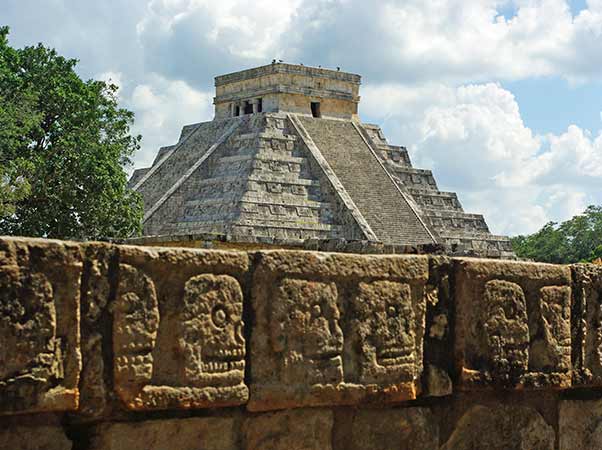
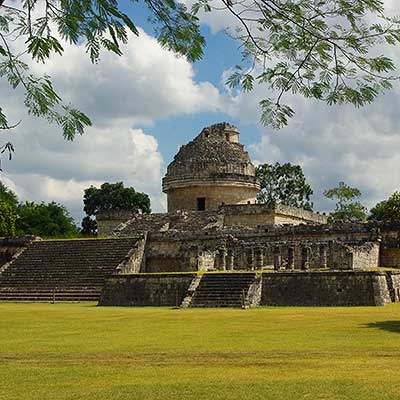
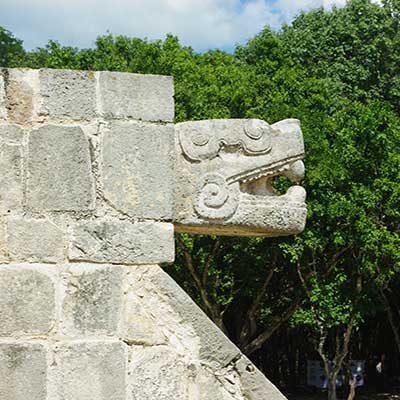
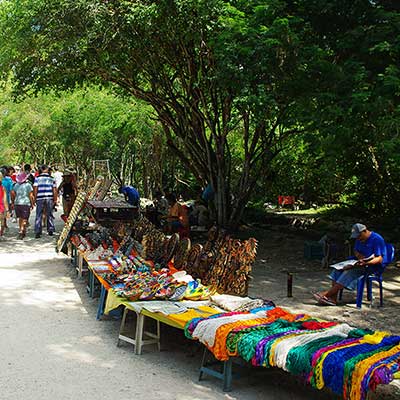
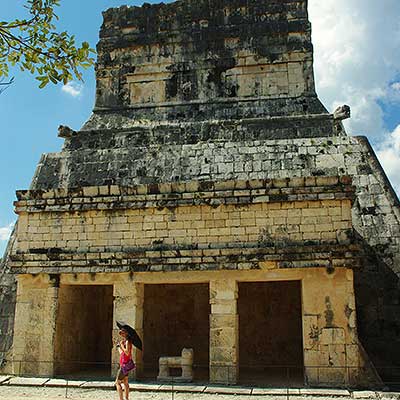
Uxmal
About 40 miles south of Merida, Uxmal is unique due to its Puuc architectural style. Uxmal impresses with its intricate stone carvings and impressive structures.
The first thing you’ll see as you enter is the impressive Pyramid of the Magician, with its unique rounded base. The Governors Palace is one of the best restored of the Yucatan archeological sites carvings of snakes, lattices and an amazing deity. It’s no longer possible to climb the main structures.
Nearby are the related Mayan ruins of Kabah (20 minutes), Sayil (30 minutes), and Labná (a bit over an hour)
For more information click Visiting Uxmal – Everything you need to know!
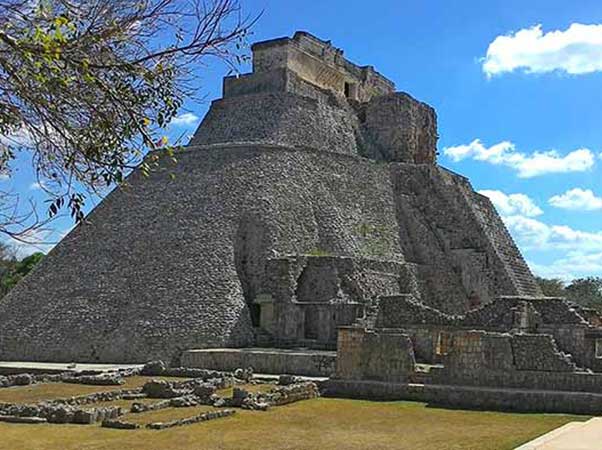
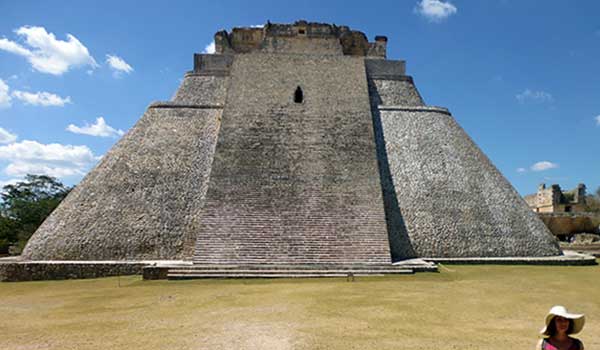
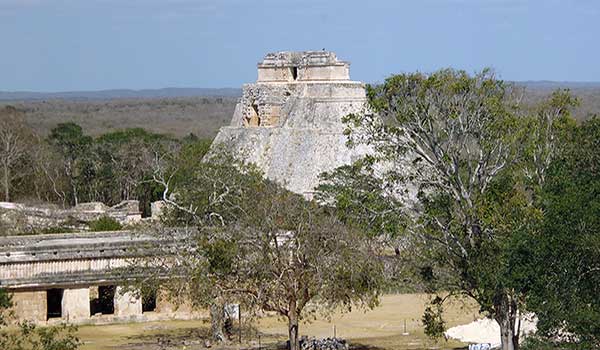
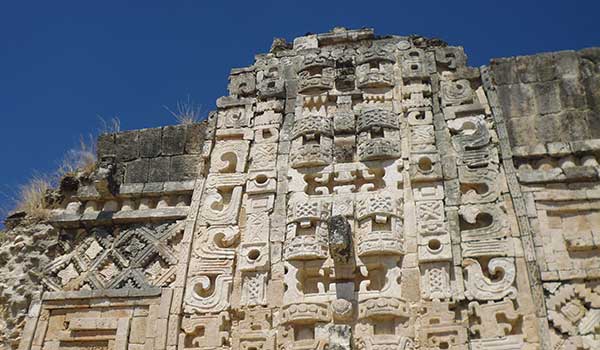
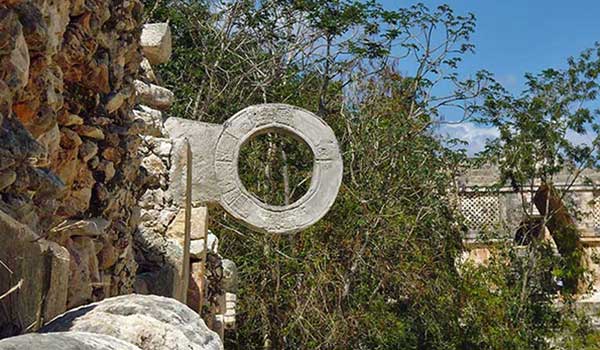
Ek Balam
About a 30-minute drive north of Valladolid, Ek Balam offers stunning temples adorned with detailed stucco sculptures. The building style is different from many other Mayan ruins and boasts some detailed carved friezes.
There are over 45 structures you can enjoy but the main attraction is the large Acropolis. This is one of the largest Mayan structures in the Yucatan.
As December 2023, you can still climb it to get an amazing view of the surrounding area.
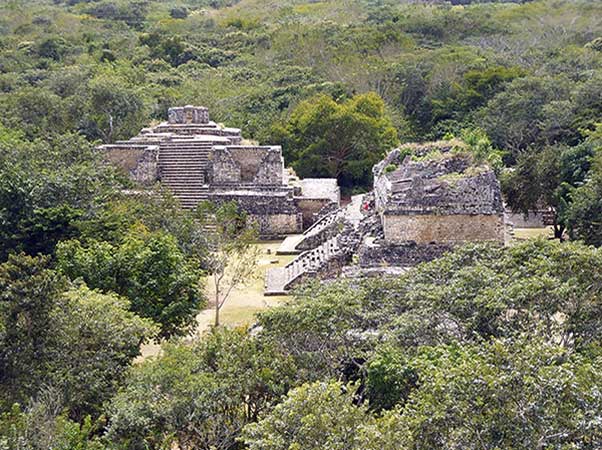
Edzna
Close to Campeche, Edzna was once home to about 25,000 people. It is less crowded than the Mayan ruins near the Riviera Maya. Edzna has some amazing buildings. One of the highlights of Edzna is the Great Acropolis, which stands tall offering breathtaking views of the surrounding area.
Acanceh
Roughly 30 minutes southeast of Merida, the Mayan ruins at Acanceh are in two parts. The pyramid is right next to the town square.
The Acropolis is a few blocks south among houses! You may need to speak to the guy at the Pyramid to arrange for someone to let you into the Acropolis.
Once a series of structures, the inhabitants used the stones to build the walls of their houses.
It’s worth a visit if you’re in the area. You can climb the pyramid and it has interesting statues and a frieze.
For more information click Visiting Acanceh Mayan Ruins – The Complete Guide!
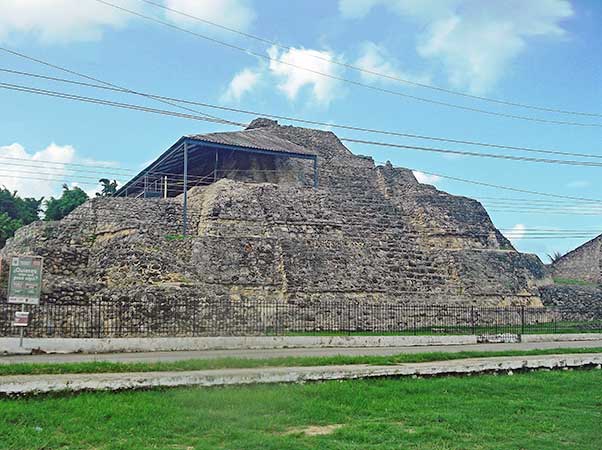
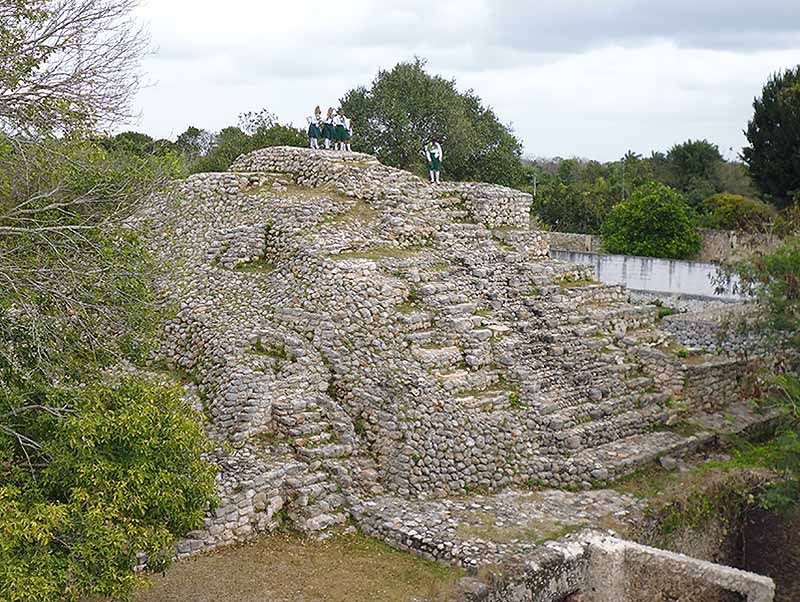
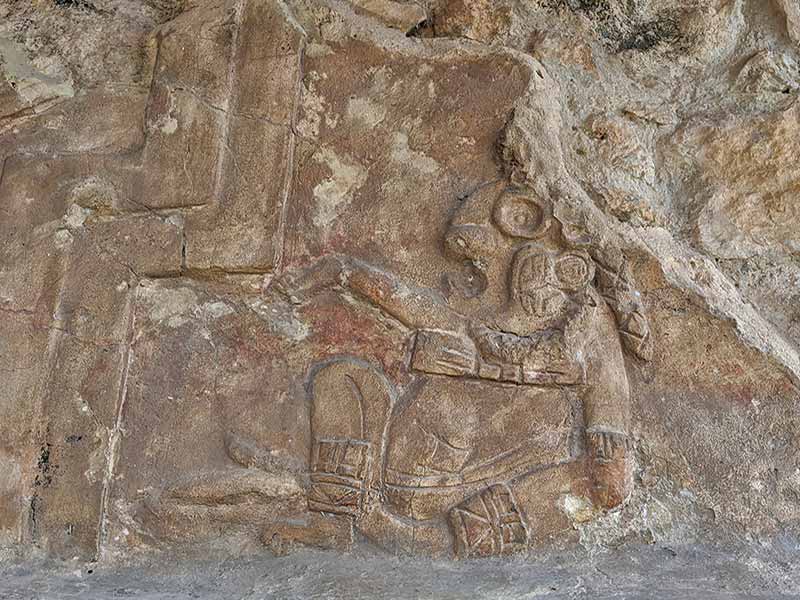
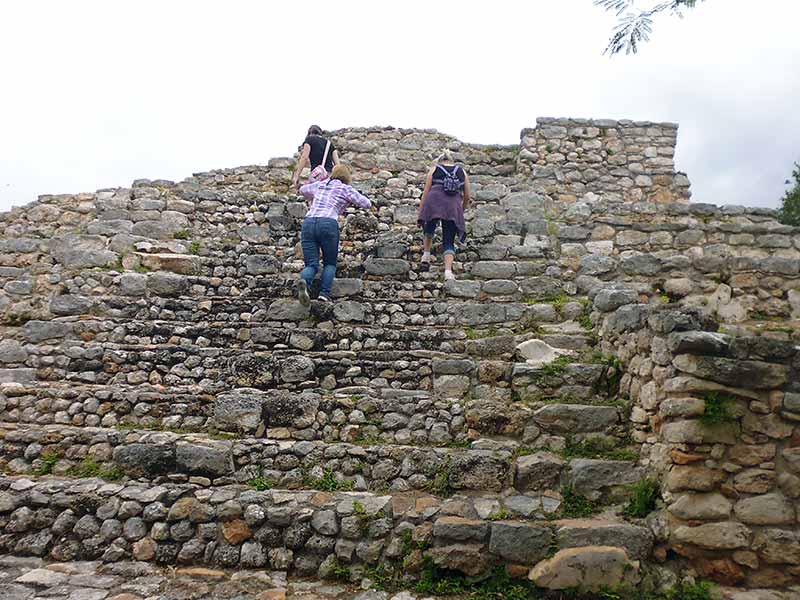
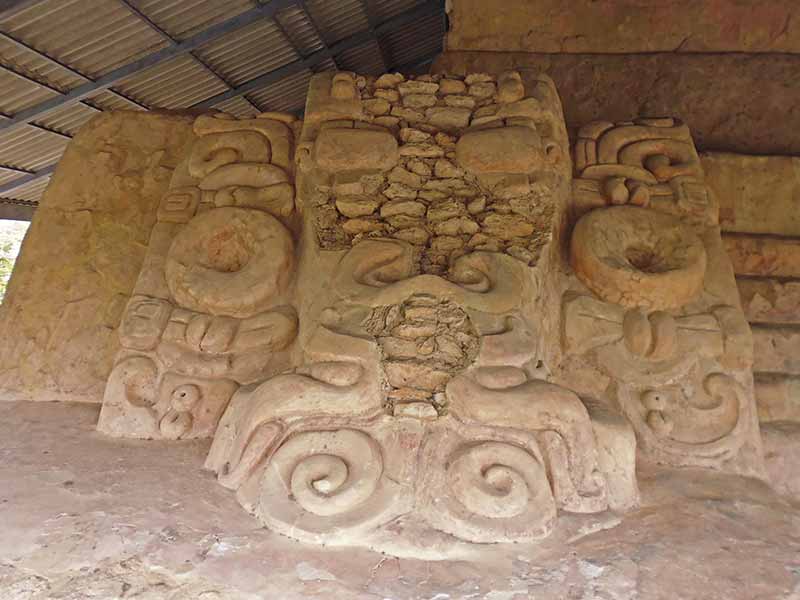
Tulum
An easy drive from Cancun (about 1 hour) and Playa del Carmen (30 minutes), or even closer if you’re staying in Tulum! The Tulum Mayan ruins offer a unique location, overlooking the Caribbean Sea from the cliff top.
There are some wonderful well-preserved structures, laid out with easy access along paths. It can get crowded but it’s worth a visit. We’ve been several times and have always enjoyed the location – fabulous!
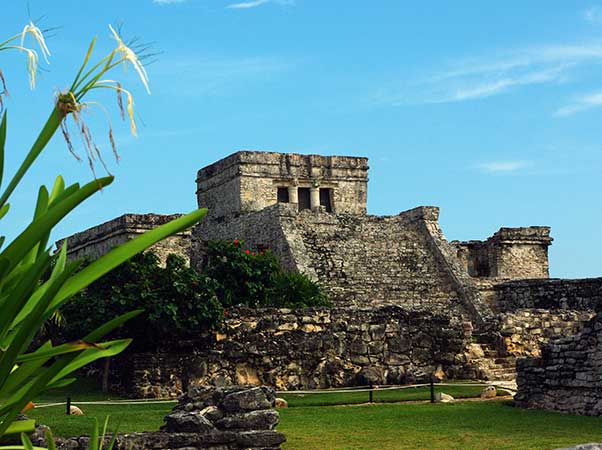
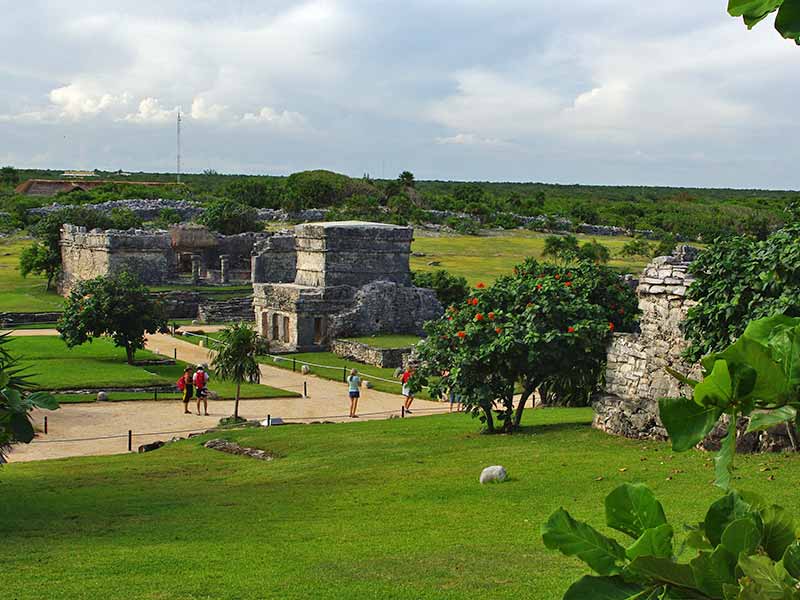
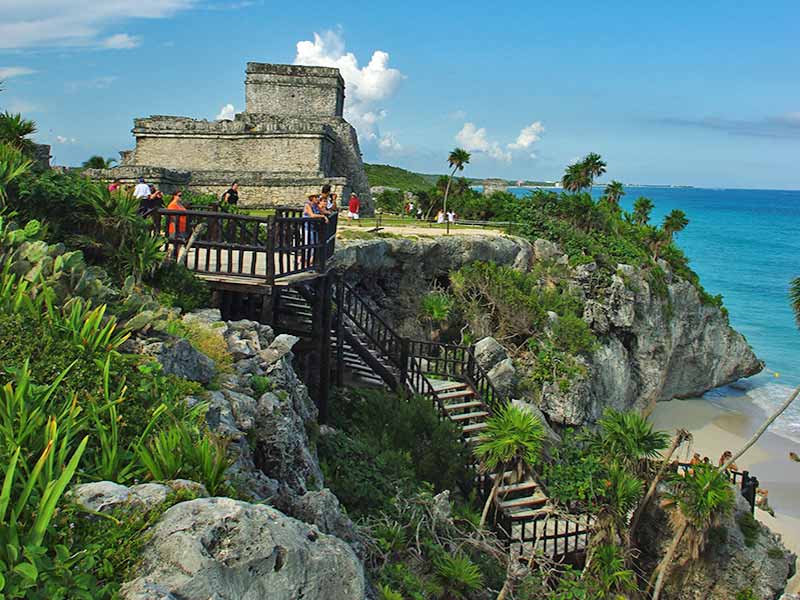
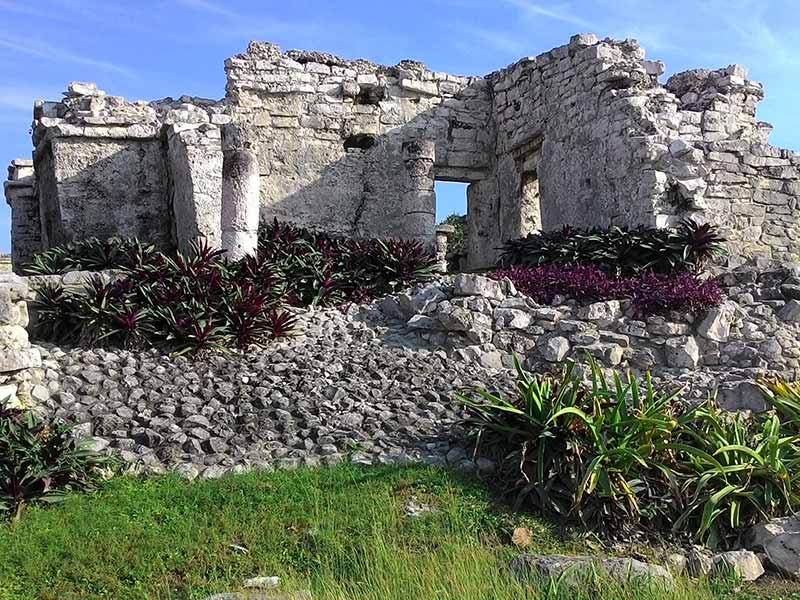
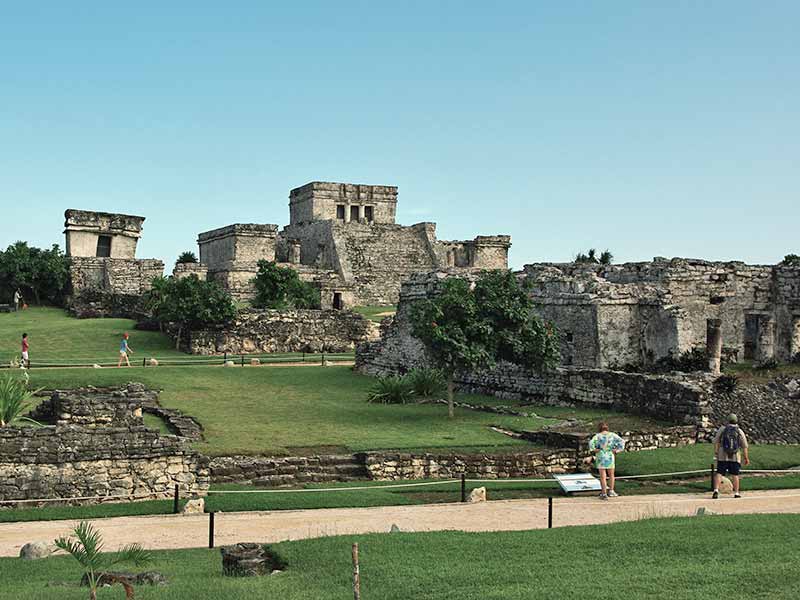
Coba
Situated about halfway between Tulum and Valladolid, Coba has some fascinating structures.
The three sites are Nohoch Mul structures, which is the pyramid. (It was possible to climb the Nohoch Mul pyramid for amazing panoramic jungle vistas but that changed recently.)
The other two sites are Conjunto Pinturas (the Painted Lintel Pyramid) and Macanxoc (a collection of altars and stelae – upright carved cylinders).
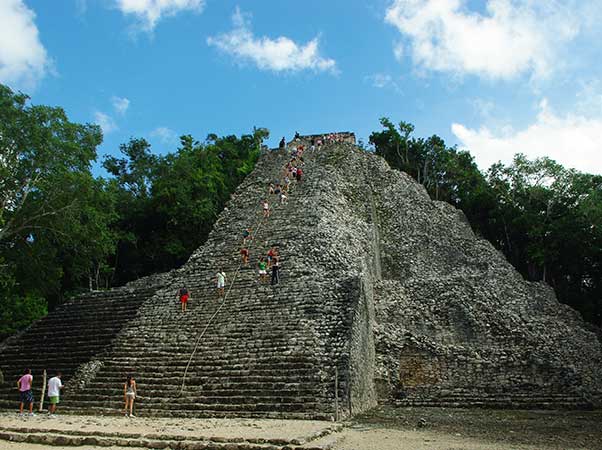
Mayapan
About 40 minutes southeast of Merida (along the same road as Acanceh), Mayapan was the most important Mayan city at the end of the Post Classic period and this is reflected in its grandeur through remnants of pyramids, palaces, and ceremonial platforms.
Never as crowded as Chichen Itza, this is a great site to visit. And it is still one of the Mayan ruins you can climb.
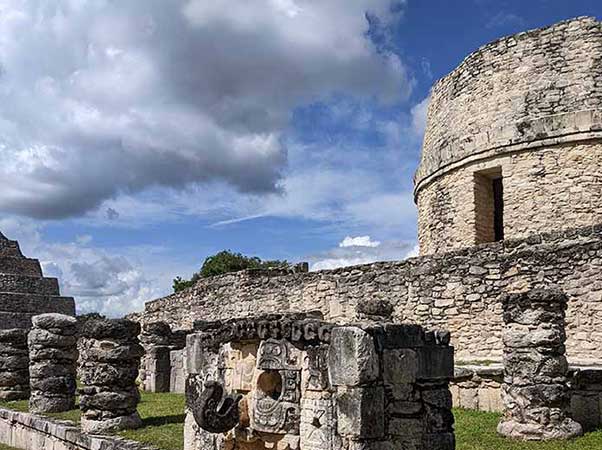
Xcambo
About 35 minutes from Progreso, itself some 40 minutes north of Merida, Xcambo offers some unique features. It is rarely crowded. Built as a port on the Gulf of Mexico, it contains unique features (including the later addition of a Spanish chapel!). Nearby you can visit the salt flats where the old Mayan methods are still in use.
If you’re looking for Mayan ruins near Merida to combine with a beach trip, this is the one!
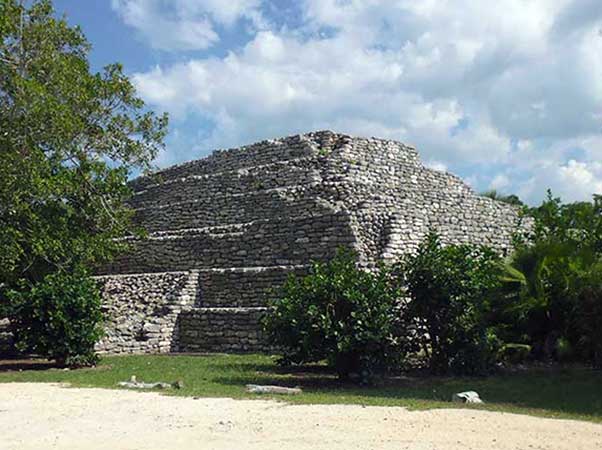
Kincih Kak Moo (Izamal)
About an hour from Merida and an hour and 20 minutes from Valladolid, Kincih Kak Moo is in the town of Izamal. There was a large Mayan complex here at one time. However, the inhabitants have scavenged most of the stones for their own buildings, leaving only the pyramid of Kincih Kak Moo and some smaller remains around the town.
This is another of the Mayan ruins you can climb. Kincih Kak Moo, has barely been restored but is still worth a visit – and there are remnant of other small ruins around the town. There also are nice cenotes nearby.
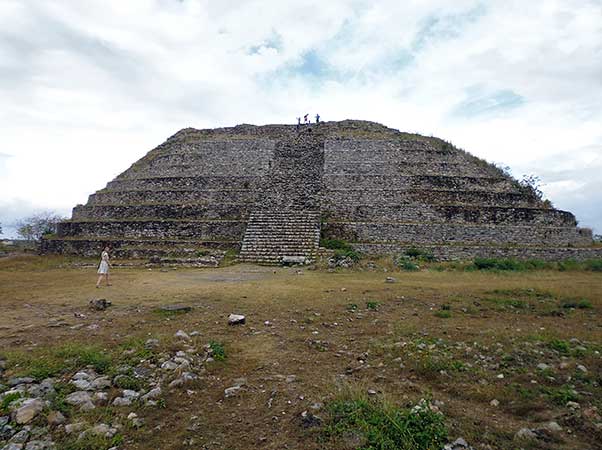
Dzibilchaltún
There are several Mayan ruins near Merida but Dzibilchaltún is only 30 minutes from the center of Merida. This makes it a great day trip from Merida.
Dzibilchaltun has some unique features – such as a Franciscan chapel in the middle of the Mayan ruins!
Located next to the charming Xlacah Cenote (which is closed for swimming), Dzibilchaltún has some excellent structures.
For more information click Everything you need to know about Dzibilchaltun.
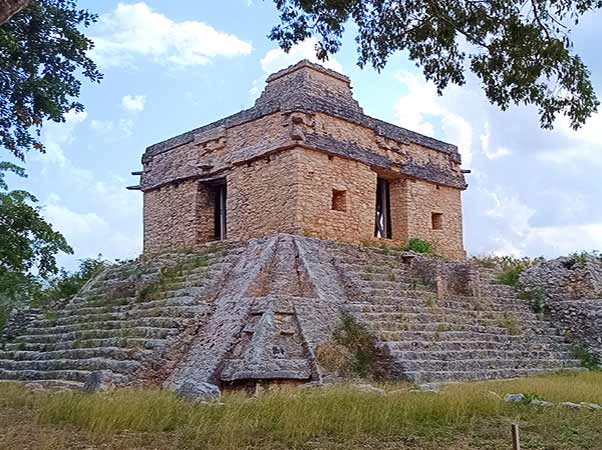
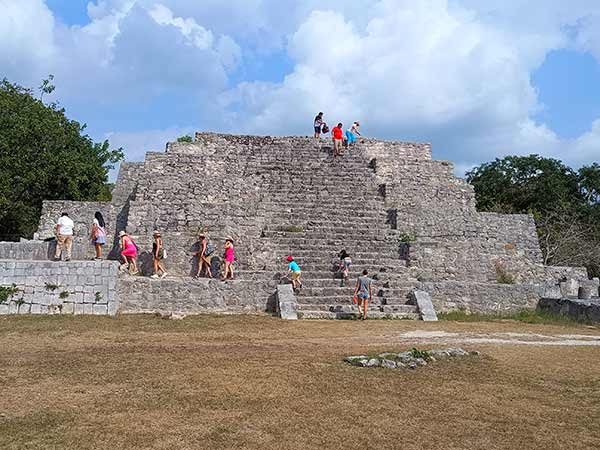
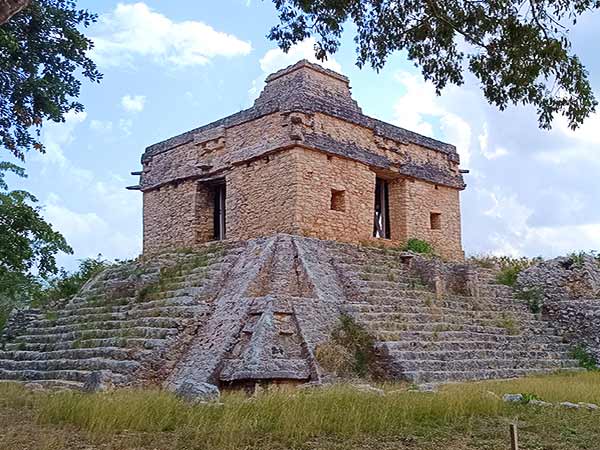
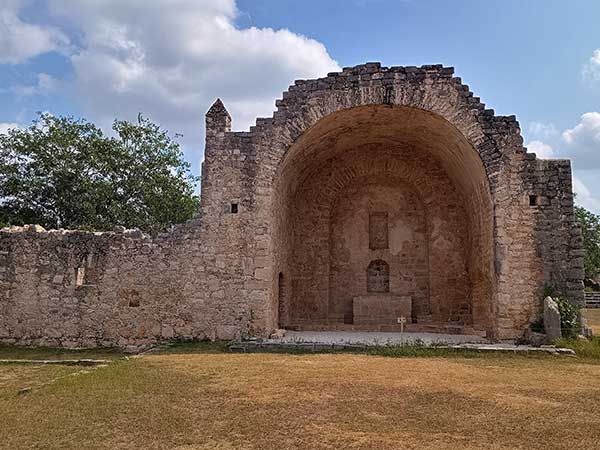
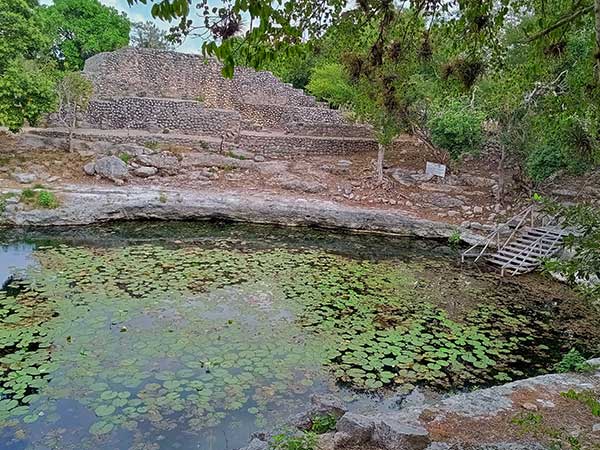
What will I see at the Mayan ruins?
Also often asked is this question is ‘Which Yucatan Peninsula Mayan Ruins in the should I visit?
To a great extent, the answer to both questions depends on where you are and your interest in Mayan ruins. The number of and access to Yucatan ruins is expanding as new ones are being rediscovered in the jungle all the time.
Some of the Mayan ruins in the Yucatan are now world-class tourist attractions. Others, especially the smaller ones and those in more remote locations are simpler – but still well worth a visit.
You will see the remnants of a recently past civilization, expertly restored. In most cases, there will be buildings dating from anywhere from 700 years ago to 900 years ago.
Structures you might see include temples, pyramids, ball courts, and civil buildings. A few sites have statues, murals, and friezes of a forgotten world of warriors and sacrifices, with images of skulls and deities.
Many Yucatan ruins have cenotes (sinkholes in the limestone filled with water) on site or nearby. In many cases, these cenotes had spiritual value to the Mayan inhabitants.
Some of these sites cover a large area. A few are the remains of cities that extended far beyond what remains. For example, the Edzna ruins are part of a city that was 6,000 acres (25 square kilometers)! But no need to worry – the areas open or accessible to tourists are much smaller.
What if I don’t speak Spanish at the Mayan Ruins?
So many foreign tourists visit the larger ruins that you shouldn’t have any problems. We’ve found that at the smaller ones, the people involved are so friendly that even no Spanish isn’t a real hindrance – and they seem genuinely pleased that a tourist has found their site!
Some sites have good signage to give you information about the statue or building, others don’t have anything. With a few exceptions, most of the signs are in Spanish. But if you have a phone with a translation app, you can easily work it out.
No matter which Mayan ruin you choose, you will be visiting a unique site. The photographs you take will be snaps you can look back on in years to come. You will have had a glimpse into a part of Yucatan history that is still not fully understood.
How do I get to the Mayan Ruins in the Yucatan?
The Mayan ruins listed below are all easily accessible to anyone visiting the Yucatan.
‘Can I visit a Mayan ruin from Cancun?’ Definitely! A few of the sites are simple coach trips from any of the Caribbean coast resorts of the Riviera Maya, like Cancun, Puerto Moreles, Playa del Carmen, and Tulum, further south.
If you just want to have a quick tour, the best way to see Mayan ruins is to join one of the coach tours offered by your hotel or a local travel company.
The Mayan Train will start operating (properly) in early 2024. Several of the sites listed below have stations close to them to allow visitors quick access from their holiday destinations. One of the stated intentions of the government was to make more Mayan ruins accessible to tourists via the Mayan Train.
It’s also possible to use public transport and taxis, although you should check out the prices first – especially in the more popular tourist areas, some taxi drivers are quick to ramp up their prices if they think they can get away with it.
Another way to visit the archeological sites is to hire a car. This will give you more freedom to come and go as you please. Some Mayan ruins are a bit too far for the resorts to provide a coach trip. Those further away are best combined with an overnight stay in either Merida or Campeche.
Hiring a car will also allow you to visit more than one site in a single day, if you want to.
What do I need to bring when I visit any Mayan Ruins?
All the Mayan ruins in the Yucatan have one thing in common – the Yucatan sun. It can be fierce. Depending on which part of the Yucatan you are visiting, the mid-day temperatures can climb to over 100f (38c). The ultraviolet is strong and, for many sites, there is little shade.
While the temperatures are lower between November and April, walking in the open even at 85f (30c) can be hot.
A good sunscreen is also important – you don’t want to ruin the rest of your holiday due to sunburn. We’ve seen tourists at some of these sites who went hatless and were bright red by the end of their visit!
It’s also a good idea to bring water. Once you are inside the Mayan archaeological sites, there are rarely places to buy drinks. At the same time, be aware of the rules of each site regarding food and drink. Some have no problem with food whereas others, like Chichén Itzá, are ok with water but do not allow food at all.
What should you wear when visiting Mayan Ruins?
Bring a hat! A baseball cap is great but make sure you protect your neck from the sun. The same goes for exposed arms and legs – light clothing that stops you from getting sunburned is worth the effort.
Many Mayan ruins in the Yucatan are spread over fairly large areas. Chichén Itzá is 4 square miles (10 square km) so wearing decent walking shoes will make your trip more comfortable.
How long should I spend at the Mayan ruins?
This will depend on the size of the site and your depth of interest – and to a lesser extent how hot it is. Even the most ardent Mayan enthusiast will struggle to spend four hours across midday at the height of a Yucatan summer.
When we take friends and visitors to different sites, it’s interesting to see how long they spend looking around. If it’s their first ruin, they are fascinated by everything – and why not? These are unique and important Mayan archaeological sites you will see nowhere else in the world.
But if our friends have already visited a few other sites, they may tend to spend less time. Although all the Mayan ruins in the Yucatan is different, and some very different, the length of time you spend will depend on your interest in Mayan history.
Tabitha can spend many hours, even at a site she has visited several times before. Lesley and I will typically spend about two hours. Obviously, a site like Acanceh, with its one small pyramid takes much less time (but still well worth a visit).
Adding a guided tour will add to your time. However, unless you’re on an organized coach trip, you should allow at least two hours. Check out the links for each site to get a better idea how much time you need.
The amazing work restoring the Yucatan Mayan Ruins
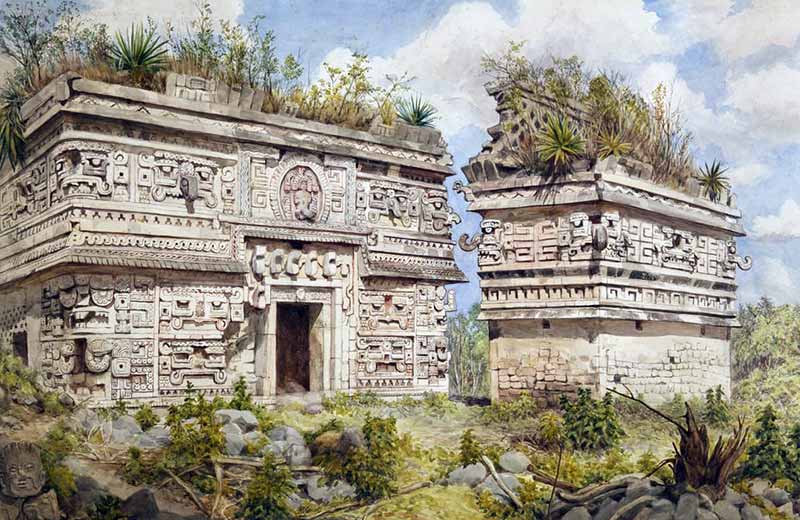
It’s worth bearing in mind that until the late 1800s, many of these Yucatan ruins had been lost or ignored by the West. They still held significance to the local Mayans but buildings, statues, and even pyramids had become overgrown and hidden by dirt, bushes, and trees.
The buildings were not just hidden from sight by nature. The rain seriously damaged the plaster and colorful paintwork. Tree roots and earthquakes damaged the buildings.
The Mayan society at its height, was complex and often warring. When the warriors of a city were defeated the city, including its temples, might be burned or destroyed. In many cases, other buildings would be built on top of the originals. In some places, there are three such layers over the original structures.
The survival of these old cities was not helped when the Spanish conquered and invaded the Yucatan. As well as destroying statues and friezes as idolatrous art, they also removed stones to build their haciendas.
With all that has happened to the Mayan sites, it is remarkable we have anything left to see! What has been accomplished is due to the hard work of archeologists, specialists, and enthusiasts, with the help of funding from the Mexican government.
Temple of Kukulcan at Chichen Itza Mayan Ruins – before and after
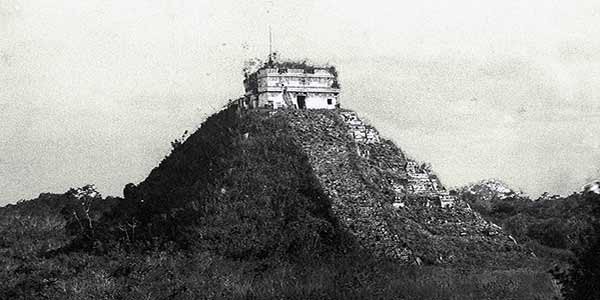
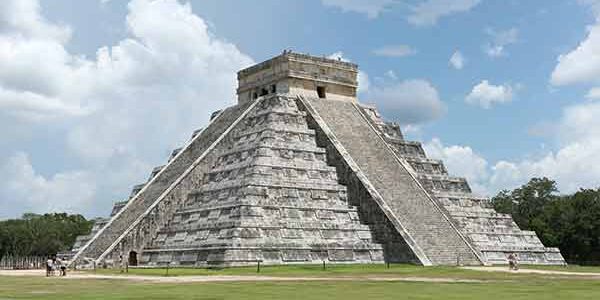
Am I seeing the original Mayan buildings or copies?
Yes and No. Few sites will be 100% original for the reasons outlined above.
Subject to how badly the original building was damaged, you are seeing the best possible recreation of how the original building looked.
Make no mistake – when you visit Mayapan, Chichén Itzá, Edzna, or Uxmal, you will see Mayan ruins as close to how they looked hundreds of years ago as possible.
Two words are typically used concerning the Mayan ruins as you see them today. Restoration and Reconstruction.
Restoration – using photos and drawings from early Western explorers we can see what the sites looked like 100 or even 200 years ago. In many cases, the buildings were still standing but some stones or statues have fallen over or broken off. Using these old images, archaeologists removed the vegetation and soil – on the way to restoring it to its former glory!
Reconstruction – when a structure is badly damaged or collapsed, more than restoration is needed. Specialists and archaeologists work together, using professional standards (which vary by country) to piece together what was there.
These professionals will study any fallen or damaged stones and buildings to reposition or rebuild them as closely to the original as possible. They may also need to replace blocks, steps, lintels, etc., that are either broken or missing.
The Mayan ruins in the Yucatan are not unique in being subject to such restoration and reconstruction. The Colosseum in Rome and Stonehenge in the UK have both been subject to similar restoration and reconstruction. Both are still on the top of every traveler’s dream list to visit!
When was the Mayan Civilization at its peak?
For many, the Mayan civilization is unknown. It’s typically not taught in schools in the US or Europe. And it’s often overshadowed by its cousin the Aztec civilization.
The Mayan civilization covered southeastern Mexico (primarily the Yucatan Peninsula but also in Chiapas), Belize, and Guatemala, as well as parts of Honduras and El Salvador.
Although the Maya were present thousands of years earlier, modern historians tend to group Mayan civilization into three main periods:
- Preclassic from about 2000 BC to 250 AD
- Classic from about 250 to 900 AD
- Postclassic from about 950 to 1539 AD
These dates are to an extent arbitrary periods and depend on which researcher you read. Which is a good indication that there is still much to learn!
For our purposes, we’re not concerned with the Preclassic period. The Mayans responsible for the architecture we can see today came later, mainly in the Postclassic period.
At its peak, the Postclassic Mayan empire encompassed vast territories across the countries mentioned above. It boasted a population numbering in the millions, mostly living in the lowlands of Guatemala. The Mayans built magnificent cities adorned with towering pyramids, intricate temples, and elaborate palaces.
The Mayans were master mathematicians and astronomers who developed sophisticated calendars that still astound scholars today.
The Mayan empire comprised a strong network of city-states, each with its own king who ruled with absolute power. There was warfare and rivalry between the various city-states but overall, it was a stable environment.
That changed from about the 9th Century AD.
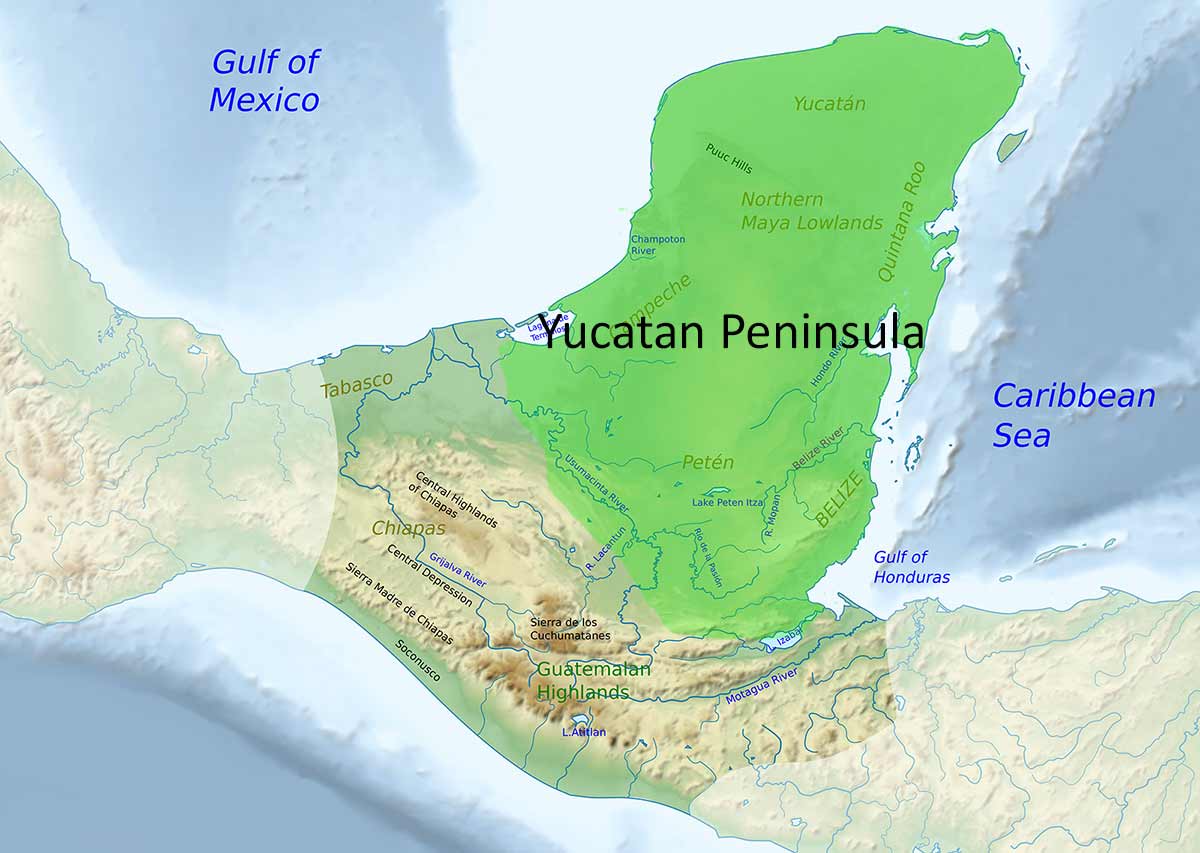
The rise of the Yucatecan Mayan influence
For political and possibly climatic reasons such as drought, many of the southern city-states failed. The inhabitants abandoned their cities and dynasties collapsed. Amazingly, this collapse and disappearance of the Mayan civilization in these areas occurred within a 50-to-100-year period, leaving large areas virtually uninhabited.
This left the northern areas, particularly those in the Yucatan in a strong position from the 9th Century. Chichén Itzá and Uxmal expanded their influence. Whereas the southern part of the civilization was based on a system of kings, the northern cities used a council-based leadership based on lineage.
Even in the Yucatan, political stability was elusive. Chichén Itzá fell from supreme power in the 11th Century. In the 12th Century, Miyapan replaced it as the point of power. Miyapans’s influence lasted until the mid-1400s when it was abandoned. The reasons seem to mimic those in the South – warfare, political issues, and natural disasters.
After Miyapan, there were no single city-states that dominated the Yucatan. In 1511, the Spanish invaded and they wrote about independent provinces that traded but had no cohesive alliances.
The Spanish exploited that situation between 1511 and 1697 as they tried to complete their invasion. Unlike their destruction of the Aztecs, they failed to defeat and fully subjugate the Mayans!
Who were the Mayans?
The average Mayan, like all the people in Mesoamerica, had a strong belief in the supernatural. Their view of the deities and cosmos had a powerful impact on their daily lives, as seen in many of the Mayan ruins.
Ancestor worship was at the core of their belief system, with the bodies of dead relatives buried beneath their houses to provide them with protection from other spirits.
The link between the mortal world and the heavens and underworld was easily breached, by either deities or demons or by the intercession of priests or kings, which in places were the same person.
Religious beliefs changed as the civilization shifted north. Deities became a greater focus of worship and kings fell from power. It appears that human sacrifice increased in importance at this time. This is also reflected in the murals and friezes of the Yucatan Mayan ruins.
Governed by the seasons along with invocations to the deities, Mayan society was primarily agricultural. The basic diet was beans, maize, and squashes, much as it is today. The forests provided extra food when needed, with the hunting of wild animals providing meat.
Domestic animals were mainly dogs, ducks, and turkeys.
Life was harsh and wars between city-states and kingdoms were frequent, with the usual sad impact on the lower classes.
The collapse of Postclassic Mayan civilization started with the fall of Miyapan in 1448. About Sixty years later the Spanish arrived and colonized the Yucatan, leaving the Mayans to fade from their previous glory and to be treated badly.
Post-Spanish History of the Mayans.
Although not directly relevant to the Mayan ruins, the Mayans have shown they are an indomitable race. They have resisted every attempt to subjugate them.
Although there have been other uprisings since the Spanish invasion, the Caste Wars are the most recent. Starting in 1857, they lasted 85 years. It was only in April 1933, that Dzula, the last independent Mayan village, was taken by force by the Mexican army after they refused to recognize the rule of the Mexican government.
These stalwarts were among the descendants of the builders of the ruins we can now visit so easily (and safely).
Today, there are over half a million Mayans in the Yucatan who still speak the Mayan language and even more who don’t. As you walk around the Yucatan today, you will inevitably hear the language spoken.
David H
After spending months in places like Playa del Carmen and Ajijic (near Lake Chapala, Guadalajara), my family and I have been living for the past four years in the Yucatan and enjoying this fabulous part of Mexico.
I've written many travel blogs for other travel sites over the years before starting Wonky Compass. I have three books published on Amazon.
Copyright 2024 www.wonkycompass.com